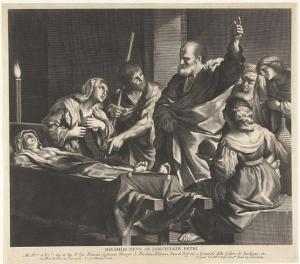Did Jesus & Peter Talk to Dead People Before They Rose from the Dead, and — Along with Elijah and Elisha — Pray for the Dead, or Only Ask Them to Move After They Were Raised?
Jason Engwer, who runs the Tribalblogue site, wrote posts entitled, “Agreement Among The Gospels About How Jesus Raised The Dead” (5-29-22) and “Did Jesus offer support for praying to the deceased by speaking to people he raised from the dead?” (3-5-23). This is my reply. His words will be in green (earlier article) and blue (later one).
*****
When Jesus raised people from the dead, he would tell the person to move in some manner, probably at least in part to demonstrate that a resurrection had occurred. A description of the person’s movement follows, which suggests that Jesus’ references to “rising” and such were about moving the body after a resurrection rather than the resurrection itself (Mark 5:41-42, Luke 7:14-15, 8:54-55, John 11:43-44; Matthew 9:25 is in agreement as far as it goes, even mentioning that Jesus took the girl’s hand, but doesn’t say whether Jesus made any comments telling her to move). We see something similar with Peter’s raising of the woman in Acts 9:40-41, perhaps in imitation of what Jesus did, but the other resurrections referred to in the Old and New Testaments don’t involve any such scenario (1 Kings 17:21-23, 2 Kings 4:34-37, 2 Kings 13:21, Matthew 27:52-53, Acts 20:10, Revelation 11:11). [italics and bolding my own]
He did often make comments like “arise” to those he raised from the dead, . . . But . . . it’s likely that he was telling the people to move in some way in order to demonstrate that they had been brought back to life (e.g., telling Lazarus to come out, after which Lazarus walked out of his tomb). Since the focus in these passages seems to be on physical demonstrations that a resurrection has occurred, interpreting a phrase like “arise” or “come out” as a command to come back to life is at best a secondary interpretation. Jesus may have been simultaneously telling these people to rise from the dead and to move their bodies in the relevant ways. But a “may” scenario is a reference to a possibility, not a probability. I see no way to demonstrate that it’s probable that Jesus was speaking to dead people in these passages. . . .
And I want to reiterate a point I’ve made many times before. What does it suggest about the weakness of the case for praying to the dead when arguments like the one I’m responding to in this post have to be resorted to by advocates of such prayers? [italics and bolding my own, excepting the word “may”]
In reply to the last sentence, I say that the weakness and desperation and special pleading are all on his side of the argument, as I will now proceed to show: so great is his pathetic sophistry and eisegesis that plain meanings of biblical texts are flat-out ignored or never even comprehended, before he goes on to make his groundless arguments. Here are the “problem texts” for his wishful interpretation:
Luke 8:52-55 (RSV) And all were weeping and bewailing her; but he said, “Do not weep; for she is not dead but sleeping.” [53] And they laughed at him, knowing that she was dead. [54] But taking her by the hand he called, saying, “Child, arise.” [55] And her spirit returned, and she got up at once; and he directed that something should be given her to eat.
This verse alone makes mincemeat of Jason’s contentions, because the order of events is reversed (a. Jesus’ words, b. the child is raised, c. she gets up) from what he proposes (a. the child is raised, b. Jesus words, c. she gets up). His nonsense cannot be reconciled with the text above. And when that happens, one who wishes to be “biblical” must give up their wishful thinking. The only reason Jason attempts this absurd explanation is because he believes the prior falsehood that no one can ever communicate with a dead person. Jesus just undeniably did that here (before “her spirit returned”), so, so much for that!
Acts 9:40-41 But Peter put them all outside and knelt down and prayed; then turning to the body he said, “Tabitha, rise.” And she opened her eyes, and when she saw Peter she sat up. [41] And he gave her his hand and lifted her up. Then calling the saints and widows he presented her alive.
This is the second fatal passage for Jason’s contentions. This has everything all together: Peter prayed for a dead person. We know this for a fact because any and every commentator would agree that he was praying that she would be raised. After his prayer, the text says that he spoke to a “body” and not a person who was alive. No one says that they talked to a body if the person is alive. I wouldn’t say about my wife, “I turned to Judy’s body and asked her if she wanted to go out to dinner.” That’s clearly absurd.
No; the text plainly asserts that Tabitha was still dead. Peter prayed while she was, which means both that 1) he prayed for the dead, and 2) he prayed / talked to the dead. The latter is anathema in Protestantism, and the former is for most Protestants. But here is Peter undeniably doing it, as Jesus had in Luke 8.
But there’s still more!
1 Kings 17:17-23 After this the son of the woman, the mistress of the house, became ill; and his illness was so severe that there was no breath left in him. [18] And she said to Eli’jah, “What have you against me, O man of God? You have come to me to bring my sin to remembrance, and to cause the death of my son!” [19] And he said to her, “Give me your son.” And he took him from her bosom, and carried him up into the upper chamber, where he lodged, and laid him upon his own bed. [20] And he cried to the LORD, “O LORD my God, hast thou brought calamity even upon the widow with whom I sojourn, by slaying her son?” [21] Then he stretched himself upon the child three times, and cried to the LORD, “O LORD my God, let this child’s soul come into him again.” [22] And the LORD hearkened to the voice of Eli’jah; and the soul of the child came into him again, and he revived. [23] And Eli’jah took the child, and brought him down from the upper chamber into the house, and delivered him to his mother; and Eli’jah said, “See, your son lives.”
This is a reiteration of the sequence that we also saw in Luke 8:52-55 (a. Elijah’s’ words [including prayers for the dead], b. the child is raised, c. he gets up). In Luke the terminology of “her spirit returned” is used. In 1 Kings it’s ” the soul of the child came into him again” (cf. Rev 11:11).
2 Kings 4:32-37 When Eli’sha came into the house, he saw the child lying dead on his bed. [33] So he went in and shut the door upon the two of them, and prayed to the LORD. [34] Then he went up and lay upon the child, putting his mouth upon his mouth, his eyes upon his eyes, and his hands upon his hands; and as he stretched himself upon him, the flesh of the child became warm. [35] Then he got up again, and walked once to and fro in the house, and went up, and stretched himself upon him; the child sneezed seven times, and the child opened his eyes. [36] Then he summoned Geha’zi and said, “Call this Shu’nammite.” So he called her. And when she came to him, he said, “Take up your son.” [37] She came and fell at his feet, bowing to the ground; then she took up her son and went out.
The same sequence occurs for a third time (a. Elisha’s words [including prayers for the dead], b. the child is raised, c. he gets up). Note that all of these arguments come from the very biblical passages that Jason noted (thanks for saving me the trouble, my brother in Christ!). Game, set, match. Readers must choose to either be biblical and follow the Catholic and plain biblical interpretation, or unbiblical and eisegetical and follow the standard Protestant special pleading about what is occurring in these incidents. I didn’t write biblical passages. I’m simply reporting them and defending the clear and perspicuous meaning of Scripture (as our Protestant brethren always urge all of us to do; glad to oblige!).
***
Practical Matters: Perhaps some of my 4,200+ free online articles (the most comprehensive “one-stop” Catholic apologetics site) or fifty-one books have helped you (by God’s grace) to decide to become Catholic or to return to the Church, or better understand some doctrines and why we believe them.
Or you may believe my work is worthy to support for the purpose of apologetics and evangelism in general. If so, please seriously consider a much-needed financial contribution. I’m always in need of more funds: especially monthly support. “The laborer is worthy of his wages” (1 Tim 5:18, NKJV). 1 December 2021 was my 20th anniversary as a full-time Catholic apologist, and February 2022 marked the 25th anniversary of my blog.
PayPal donations are the easiest: just send to my email address: [email protected]. You’ll see the term “Catholic Used Book Service”, which is my old side-business. To learn about the different methods of contributing, including 100% tax deduction, etc., see my page: About Catholic Apologist Dave Armstrong / Donation Information. Thanks a million from the bottom of my heart!
***
Photo credit: Cornelis Bloemaert II (1603-1692): The revival of Tabita by the apostle Peter [public domain / Look and Learn: History Picture Archive]
***
Summary: Anti-Catholic polemicist Jason Engwer contends that Jesus, Peter, Elijah, & Elisha never made prayers to & for the dead before raising them from the dead. Wrong!














